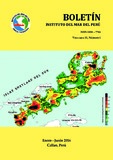Por favor, use este identificador para citar o enlazar este ítem:
https://hdl.handle.net/20.500.12958/3078| Título : | Fitoplancton del estrecho de Bransfield e isla Elefante durante el verano austral 2006 |
| Otros títulos : | Phytoplankton of Bransfield Strait and Elephant Island during austral summer of 2006 |
| Autor : | Ochoa López, Noemí Gómez Caballero, Olga Baylón, Maribel |
| Palabras clave : | Fitoplancton;Antártida;Estrecho De Bransfield;Isla Elefante |
| Fecha de publicación : | 2016 |
| Editorial : | Callao |
| Citación : | Bol Inst Mar Perú 31(1), 2016: p. 58-63 |
| Citación : | Boletín IMARPE;Vol. 31 n° 1, 2016 |
| Resumen : | Durante el verano austral 2006, se estudió la distribución y
estructura de la comunidad fitoplanctónica en el estrecho Bransfield y la isla Elefante. Las muestras de agua se tomaron con botella Niskin a diferentes profundidades. El análisis cuantitativo se realizó según el método
de sedimentación de Utermöhl. Los valores integrados de densidad para la columna de agua de la superficie
a 100 m de profundidad, mostraron valores mayores de 300,000 celx103.m-2. Las especies dominantes fueron:
Fragilariopsis sp., Thalassiosira antarctica, Pseudonitzschia prolongatoides, P. delicatissima y Porosira glacialis.
Verticalmente las mayores densidades se encontraron entre 0 y 30 m de profundidad. Con pocas excepciones
el fitoplancton estuvo dominado por los microflagelados (78%), el segundo grupo en importancia fue el de
las diatomeas (18%). Los valores del índice de diversidad fueron menores de 1,6 bits/cel. En el área de estudio
el fitoplancton mostró alta homogeneidad evidenciada por alta similaridad entre muestras (90%). ABSTRACT: The distribution and structure of the phytoplankton community in Bransfield Strait and Elephant Island were studied during Austral Summer of 2006. The seawater samples were collected using a Niskin bottle at different depths. The quantitative analysis was performed by the Utermöhl sedimentation method. The integrated values of density in the water column, from the surface to a depth of 100 m, were higher than 300,000 celx103.m-2. The dominant species were Fragilariopsis sp., Thalassiosira antarctica, Pseudonitzschia prolongatoides, P. delicatissima and Porosira glacialis. Vertically, the higher densities were recorded from surface to a depth of 30 m. With a few exceptions the phytoplankton was dominated by microflagellates (78%) while the diatoms were the second group in importance (18%). The diversity index values were lower than 1.6 bits/cel. In the evaluated area the phytoplankton showed a high homogeneity denoted by the high similarity among samples (90%). |
| Descripción : | Boletín IMARPE vol.31, nº 1, 2016; p. 58-63 |
| URI : | https://hdl.handle.net/20.500.12958/3078 |
| Aparece en las colecciones: | Boletín 31(1), 2016 |
Ficheros en este ítem:
| Fichero | Descripción | Tamaño | Formato | |
|---|---|---|---|---|
| Boletin 31(1)-6.pdf | 3,3 MB | Adobe PDF |  Visualizar/Abrir |
Este ítem está sujeto a una licencia Creative Commons Licencia Creative Commons

